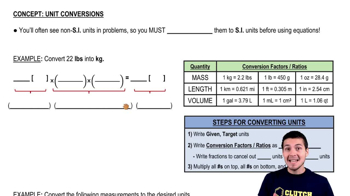Here are the essential concepts you must grasp in order to answer the question correctly.
Work in Thermodynamics
In thermodynamics, work is defined as the energy transferred to or from a system by means of a force acting over a distance. When work is done on a gas, it can change the gas's volume, pressure, or temperature. The relationship between work, pressure, and volume is crucial for understanding how gases behave under different conditions.
Recommended video:
Calculating Works For Multiple Thermodynamic Processes
Ideal Gas Law
The Ideal Gas Law is a fundamental equation in thermodynamics that relates the pressure, volume, temperature, and number of moles of an ideal gas. It is expressed as PV = nRT, where P is pressure, V is volume, n is the number of moles, R is the ideal gas constant, and T is temperature. This law helps in calculating changes in gas properties when work is done on or by the gas.
Recommended video:
Ideal Gases and the Ideal Gas Law
Volume and Units Conversion
In physics, it is often necessary to convert between different units of measurement. In this context, volume may need to be expressed in cubic centimeters (cm³) instead of liters or other units. Understanding how to convert between these units is essential for accurately solving problems related to gas behavior and work done on the gas.
Recommended video:
 Knight Calc 5th Edition
Knight Calc 5th Edition Ch 19: Work, Heat, and the First Law of Thermodynamics
Ch 19: Work, Heat, and the First Law of Thermodynamics Problem 19
Problem 19


